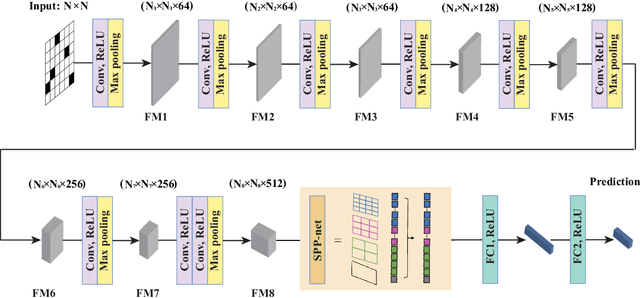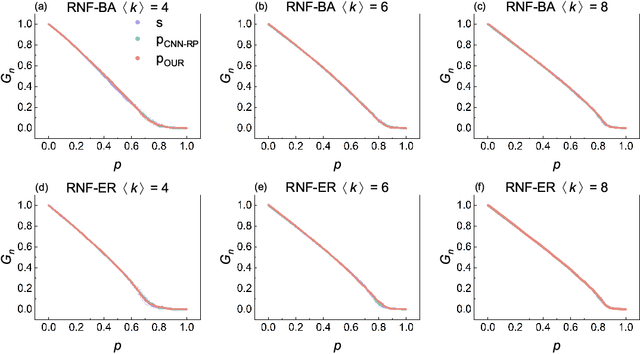Zong-fu Luo
Node Centrality Approximation For Large Networks Based On Inductive Graph Neural Networks
Mar 08, 2024Abstract:Closeness Centrality (CC) and Betweenness Centrality (BC) are crucial metrics in network analysis, providing essential reference for discerning the significance of nodes within complex networks. These measures find wide applications in critical tasks, such as community detection and network dismantling. However, their practical implementation on extensive networks remains computationally demanding due to their high time complexity. To mitigate these computational challenges, numerous approximation algorithms have been developed to expedite the computation of CC and BC. Nevertheless, even these approximations still necessitate substantial processing time when applied to large-scale networks. Furthermore, their output proves sensitive to even minor perturbations within the network structure. In this work, We redefine the CC and BC node ranking problem as a machine learning problem and propose the CNCA-IGE model, which is an encoder-decoder model based on inductive graph neural networks designed to rank nodes based on specified CC or BC metrics. We incorporate the MLP-Mixer model as the decoder in the BC ranking prediction task to enhance the model's robustness and capacity. Our approach is evaluated on diverse synthetic and real-world networks of varying scales, and the experimental results demonstrate that the CNCA-IGE model outperforms state-of-the-art baseline models, significantly reducing execution time while improving performance.
A Quick Framework for Evaluating Worst Robustness of Complex Networks
Feb 28, 2024



Abstract:Robustness is pivotal for comprehending, designing, optimizing, and rehabilitating networks, with simulation attacks being the prevailing evaluation method. Simulation attacks are often time-consuming or even impractical, however, a more crucial yet persistently overlooked drawback is that any attack strategy merely provides a potential paradigm of disintegration. The key concern is: in the worst-case scenario or facing the most severe attacks, what is the limit of robustness, referred to as ``Worst Robustness'', for a given system? Understanding a system's worst robustness is imperative for grasping its reliability limits, accurately evaluating protective capabilities, and determining associated design and security maintenance costs. To address these challenges, we introduce the concept of Most Destruction Attack (MDA) based on the idea of knowledge stacking. MDA is employed to assess the worst robustness of networks, followed by the application of an adapted CNN algorithm for rapid worst robustness prediction. We establish the logical validity of MDA and highlight the exceptional performance of the adapted CNN algorithm in predicting the worst robustness across diverse network topologies, encompassing both model and empirical networks.
Comprehensive Analysis of Network Robustness Evaluation Based on Convolutional Neural Networks with Spatial Pyramid Pooling
Aug 10, 2023



Abstract:Connectivity robustness, a crucial aspect for understanding, optimizing, and repairing complex networks, has traditionally been evaluated through time-consuming and often impractical simulations. Fortunately, machine learning provides a new avenue for addressing this challenge. However, several key issues remain unresolved, including the performance in more general edge removal scenarios, capturing robustness through attack curves instead of directly training for robustness, scalability of predictive tasks, and transferability of predictive capabilities. In this paper, we address these challenges by designing a convolutional neural networks (CNN) model with spatial pyramid pooling networks (SPP-net), adapting existing evaluation metrics, redesigning the attack modes, introducing appropriate filtering rules, and incorporating the value of robustness as training data. The results demonstrate the thoroughness of the proposed CNN framework in addressing the challenges of high computational time across various network types, failure component types and failure scenarios. However, the performance of the proposed CNN model varies: for evaluation tasks that are consistent with the trained network type, the proposed CNN model consistently achieves accurate evaluations of both attack curves and robustness values across all removal scenarios. When the predicted network type differs from the trained network, the CNN model still demonstrates favorable performance in the scenario of random node failure, showcasing its scalability and performance transferability. Nevertheless, the performance falls short of expectations in other removal scenarios. This observed scenario-sensitivity in the evaluation of network features has been overlooked in previous studies and necessitates further attention and optimization. Lastly, we discuss important unresolved questions and further investigation.
 Add to Chrome
Add to Chrome Add to Firefox
Add to Firefox Add to Edge
Add to Edge